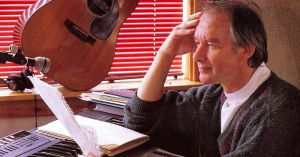The Czech Museum’s recent discovery of a long-lost Mozart composition on Lorenzo Da Ponte’s poetry reignited my fascination with Mozart’s Jewish librettist, whose “lines had both brilliance and flare,” according to Mozart’s biographer Marcia Davenport, “[and] struck themes from Wolfgang’s imagination like hammers upon flint.”
This was a combination which gave us masterpieces like The Marriage of Figaro, Don Giovanni and Cosi Fan Tutte: a partnership whose equal has yet to be surpassed.
Our story starts in a hot-punch tavern located on a cobblestone sleepy back alley buried in the immense shadows of Romanesque arches, Gothic ribbed vaults and triumphal Baroque towers ornamenting the ancient city of Prague in 1787. In the alehouse, three men dressed in breeches, powdered wigs, and tricorne hats, engrossed in a discussion, were putting the finishing touches to Don Giovanni: considered by many to be the greatest opera ever composed.
READ: SERGEI EISENSTEIN’S CONTINUING LEGACY – ORWELL TO THE HOBBIT
They were Giacomo Casanova, allegedly the greatest lover; Wolfgang Amadeus Mozart, indisputably the most sublime composer; and Da Ponte, a gifted poet. The opera’s subject is universally seductive, the music surreal, the poetry redolent with pathos, and the story encompasses every emotion familiar to ordinary people ranging from fear to revenge; from lust to anger; and, from passion to tenderness. Little wonder that in a letter to Louise Colet, Gustave Flaubert declared Mozart’s Don Giovanni, along with Hamlet and the sea, “the three finest things God ever made.”
One suspects that such a perfect libretto could not have been written without the poet being intimately familiar with the subject. The Spanish film director Carlos Saura, in his fictionalized life of Da Ponte, Io, Don Giovanni, comes very close to the truth as he links his early life with the poetry of Mozart’s masterpiece. But beyond Da Ponte’s lifestyle, in the opera, we also see a canon of Jewish folklore come alive as in the finale when a huge marble statue is turned into flesh to exact vengeance on a murderer. Indeed, the oblique reference to the Yiddish legend of Der Golem was not lost on Czech audiences.
Born to religious Jewish parents in the Venetian ghetto, Da Ponte converted with his family and was baptized in 1763, just after death of his mother and before he reached bar mitzvah age. Although he became a priest, he entertained doubts about doctrinal and moral matters as he found his true spiritual vocation in temporal love. While priest of the church of San Luca, he took a mistress, with whom he had two children. At his 1779 trial, where he was charged with “public concubinage,” it was also alleged that he had been living in and running a house of light virtues and gambling.
It was in such a milieu that he met his consigliere in all matters of amore, Casanova. After his expulsion from the Most Serene Republic of Venice, Da Ponte ran, with undiminished ardour, from scandal to scandal throughout Europe. In Dresden, he was caught having simultaneous affairs with his landlady and her daughters as he fell victim to “scheduling conflicts,” reminiscent of opera buffa sitcoms.
Finally, in Vienna with the help of the composer Salieri, he met Emperor Joseph II and subsequently Mozart, at the residence of Baron Wetzlar, a converted Jew, who supported the composer and wanted to help Da Ponte whom he recognized as a member of the tribe. A renowned Philo-Semite, Mozart embraced his new talented friend. Mozart, had, after all, just like Michelangelo – who had magnificently concealed his love of Judaism in his Sistine Chapel painting – also criticized, obliquely, the anti-Semitism of his time, in his opera Il Seraglio, by depicting the hated Turk, Selim Pasha, as a compassionate man devoid of religious prejudices.
Having lost his position in court, Da Ponte wandered in Europe before landing on the shores of the New World. There, he became a wealthy merchant from Venice, a serious art collector, a sought after bookseller, a lecturer, a noted musicologue, an impresario and finally a devoted husband. Age has a way of taming the way of all flesh; he knew how to sublimate, his mentor Casanova did not.
As a noted Renaissance scholar, he introduced the works of Dante, Petrarch and Alfieri to thousands of students at Colombia College. As a philosopher historian, he continued to espouse the universal values of the French and American revolutions. As a poet of the Enlightenment, he promoted freedom of creativity in the arts. As a humanist, he fought prejudice and poverty by giving generously to many good causes in America. Finally, he staged Don Giovanni, in memory of his friend Mozart, in 1826, in a New York music hall that would eventually become the Metropolitan Opera.
To this day, we do not know where he is buried as his end is shrouded in mystery. However, we do know that he wore a golden Star of David and one can only speculate that he might have decided to return to the faith of his forefathers in the end secretly.
READ: REMEMBERING OUR HERITAGE, BOTH PERSONAL AND NATIONAL
We also do not know where exactly Mozart’s earthly remains rest in the Marxer Friedhof cemetery in Vienna, as mass paupers’ graves were often disinterred and moved. The same goes for Casanova; his tomb no longer exists as a park was constructed out of the cemetery of St. Barbara’s church just outside Castle Dux in Bohemia.
But it does not matter as their Don Giovanni will always remind us of Shelley’s The Triumph of Life
“….a gentle trace
Of light diviner than the common sun
Sheds on the common earth, and all the place
Was filled with magic sounds woven into one
Oblivious melody…”
Erol Araf is a Montreal-based strategic planning consultant.






